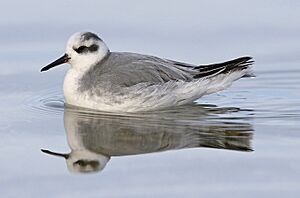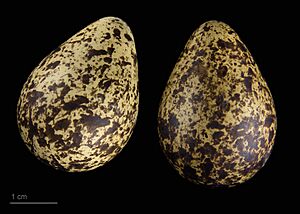Red phalarope facts for kids
Quick facts for kids Red phalarope |
|
|---|---|
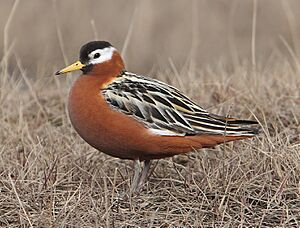 |
|
| female in breeding plumage | |
| Conservation status | |
| Scientific classification | |
| Genus: |
Phalaropus
|
| Species: |
fulicarius
|
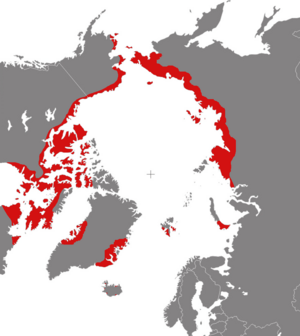 |
|
| Breeding distribution | |
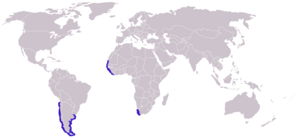 |
|
| Wintering range | |
| Synonyms | |
|
|
The Red Phalarope is a small bird that loves water. It's also known as the Grey Phalarope. These birds live and have their babies in the cold Arctic parts of North America and Eurasia.
Red Phalaropes are migratory. This means they travel very far for winter. Unlike many other water birds, they mostly fly over the ocean. They spend their winters in warm tropical seas.
Contents
How the Red Phalarope Got Its Name
The Red Phalarope was first described a long time ago. In 1750, a naturalist named George Edwards drew and wrote about this bird. He called it "The Red-footed Tringa."
Later, in 1758, the famous Swedish scientist Carl Linnaeus gave the bird its scientific name, Tringa fulicaria. Today, it's known as Phalaropus fulicarius.
The name "phalarope" comes from old Greek words. These words mean "coot" and "foot." The word "fulicarius" comes from a Latin word for "coot." Both coots and phalaropes have special lobed toes. These toes help them swim!
What Does a Red Phalarope Look Like?
The Red Phalarope is about 21 centimeters (8.3 inches) long. It has special lobed toes and a straight beak. Its beak is a bit thicker than other phalaropes.
- Breeding Female: During breeding season, the female is mostly dark brown and black on top. Her belly is red, and she has white patches on her cheeks. Her beak is yellow with a black tip.
- Breeding Male: The male looks similar to the female but his colors are not as bright.
- Young Birds: Young phalaropes are light grey and brown on top. Their undersides are a buff color, and they have a dark patch through their eye.
- Winter Plumage: In winter, the birds are mostly grey on top and white underneath. They always keep that black patch around their eye. Their beak turns black in winter.
When they call out, it sounds like a short beek.
Reproduction and Family Life
Red Phalaropes are special because their family roles are opposite to most birds!
- Females are in charge: The female phalaropes are bigger and more colorful than the males. They are the ones who chase after males. They also compete for the best places to build a nest. Females will even bravely defend their nests and chosen mates.
- Males care for the young: Once the female lays her olive-brown eggs, she starts her long journey south. She leaves the male to do all the work! The male phalarope sits on the eggs to keep them warm. He also takes care of the baby birds once they hatch.
Females usually lay three to six eggs in a nest on the ground, close to water. The eggs hatch in about 18 or 19 days. The young birds mostly find their own food. They can fly on their own within 18 days of being born.
How Red Phalaropes Behave
When a Red Phalarope is looking for food, it often swims in fast, small circles. This makes a tiny whirlpool in the water. Scientists think this helps the bird by bringing food up from the bottom of shallow water. The bird then reaches its beak into the swirling water to grab small insects or crustaceans. Sometimes, they even fly up to catch insects in the air!
Out in the open ocean, you can find them where ocean currents meet. They are often seen near groups of whales. When it's not nesting season, they often travel together in large groups.
These birds are often very calm and don't seem scared of people.
Status and Conservation
The Red Phalarope is a bird that is protected by an important agreement. This agreement is called the Agreement on the Conservation of African-Eurasian Migratory Waterbirds (AEWA). It helps protect birds that migrate across Africa and Eurasia.



